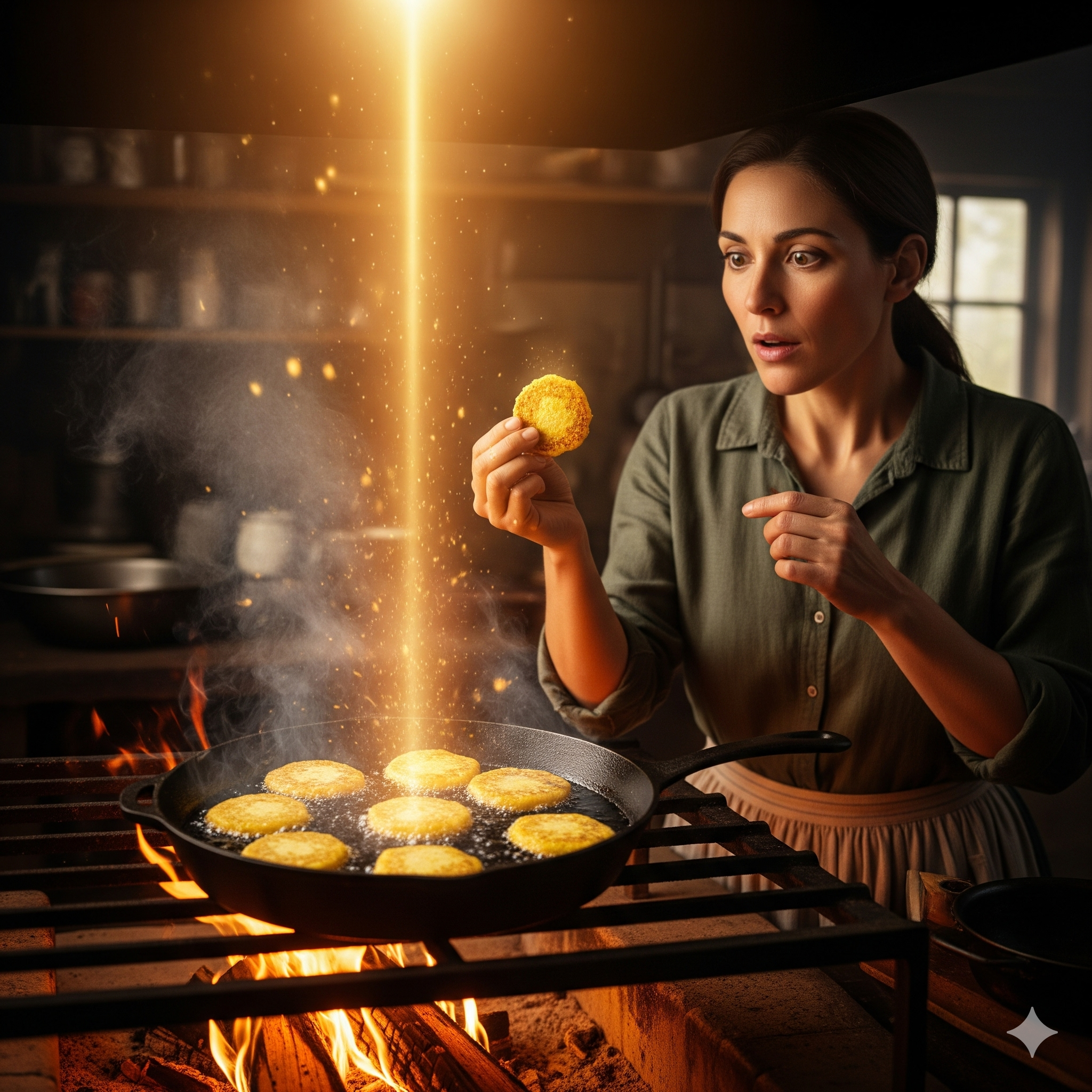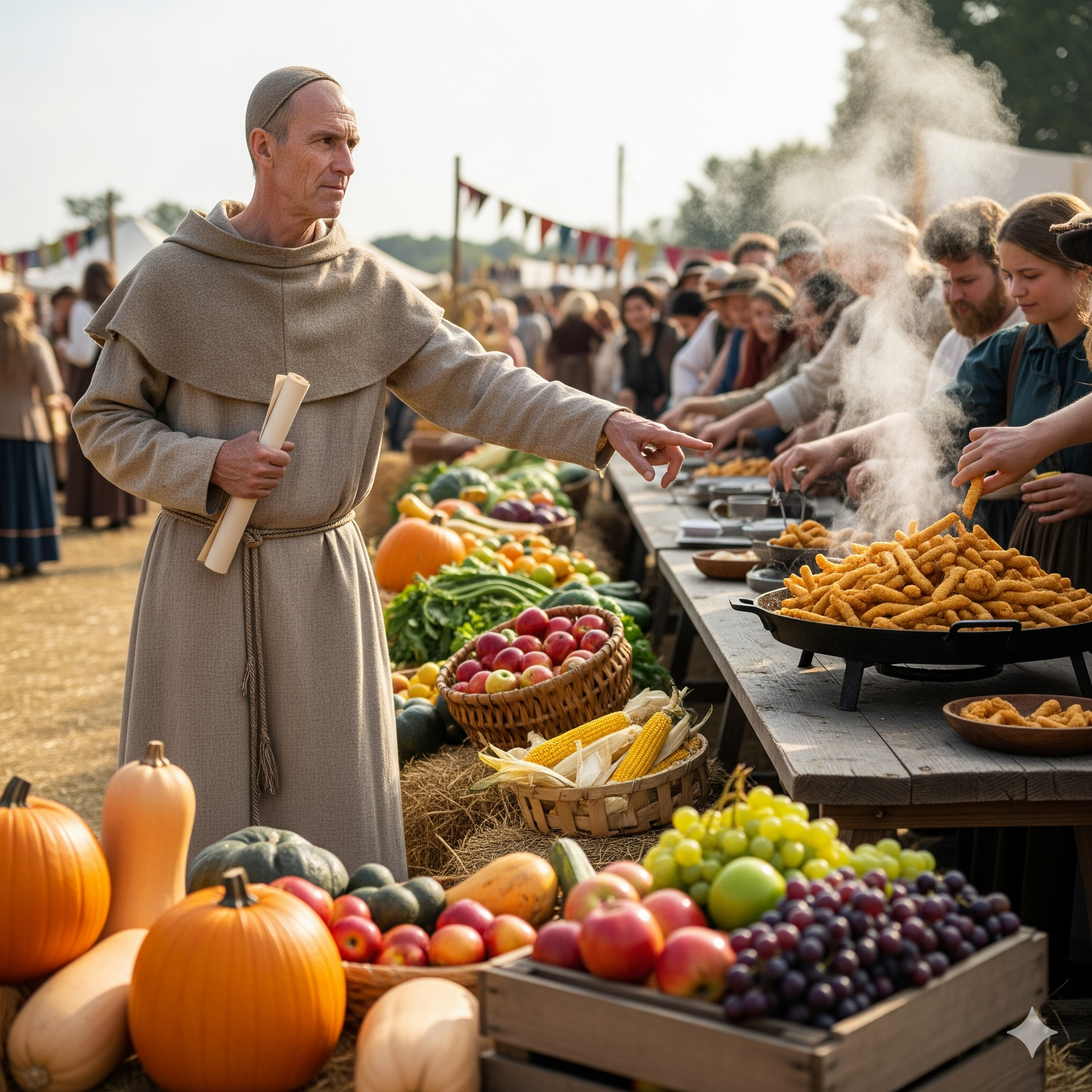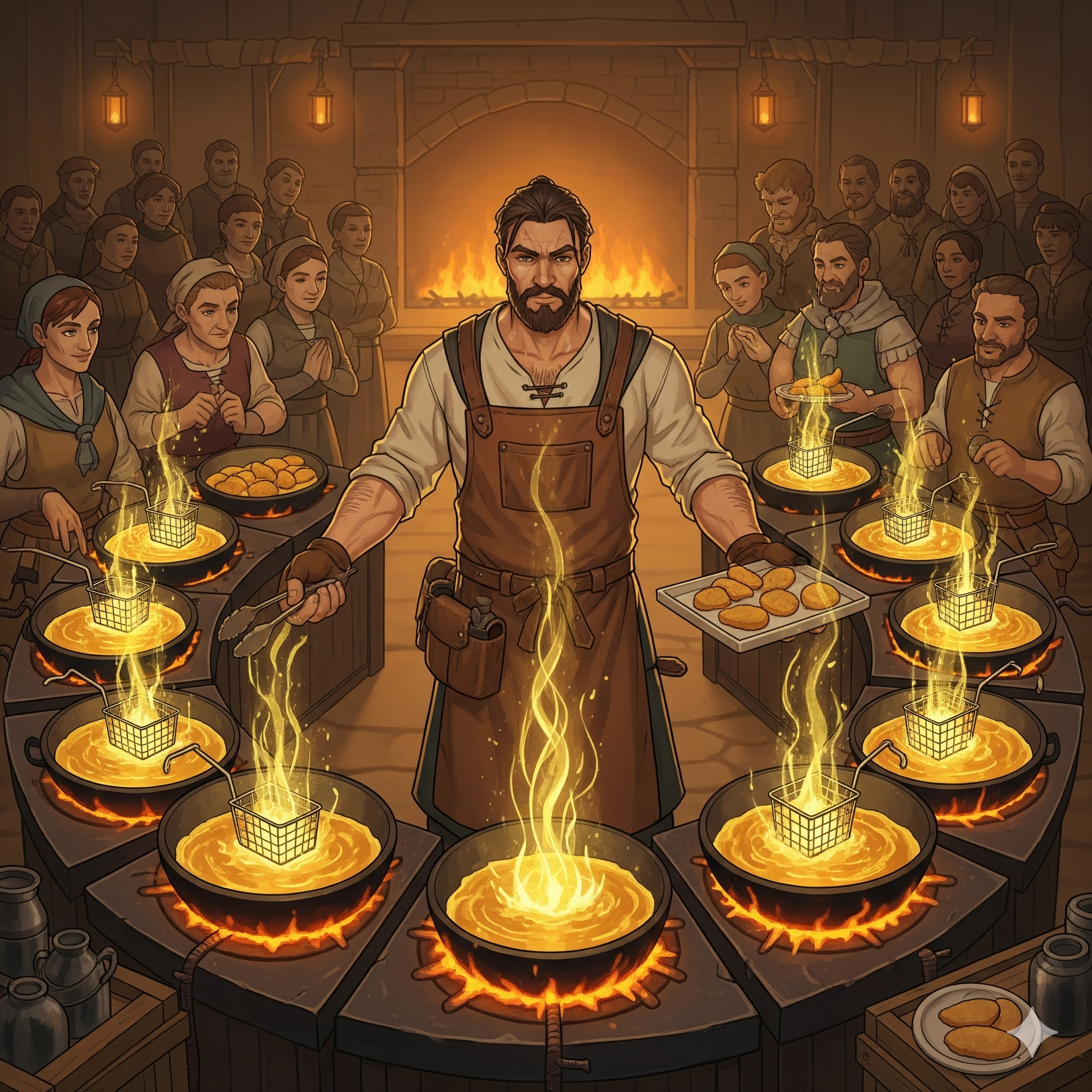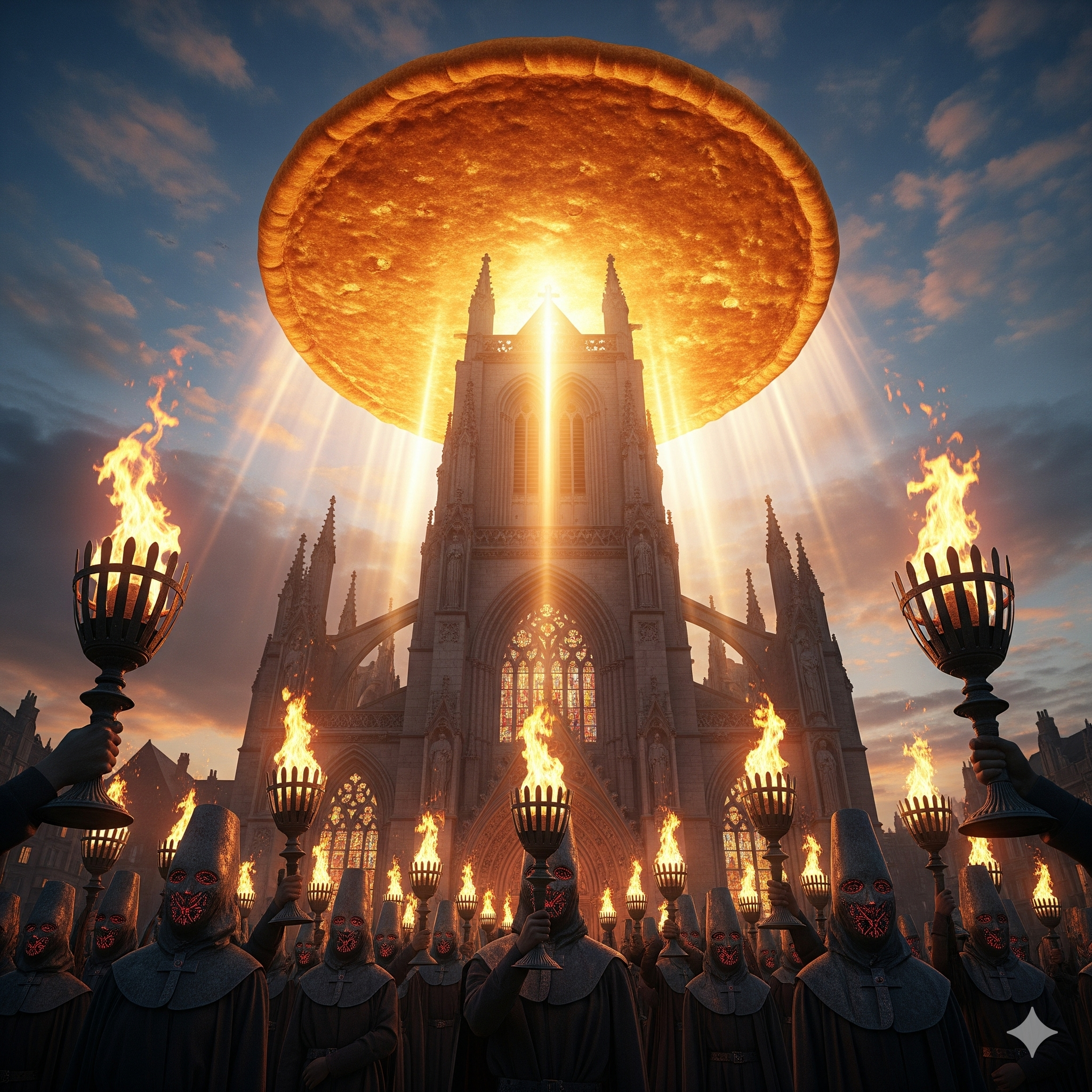The Saga of the Holy Crunch: A Revelation in Fire and Flour
Part I: The Wilderness of Unfried Souls (Late 19th Century, American Frontier)
The dust of the American frontier was thick with the scent of pine, desperation, and nascent faiths. In the waning years of the 19th century, amidst the raw expanse of burgeoning towns and scattered homesteads, spiritual hunger was as palpable as the gnawing physical kind. Traditional doctrines, brought across oceans, often felt thin and brittle against the harsh realities of a land that demanded new interpretations of providence. It was into this crucible of seeking that the seeds of the Sacred Cuisine Tradition (SCT) were first sown, not in grand cathedrals, but in humble kitchens where fire and flour met necessity.
Our tale begins with **Elara Vance**, a woman whose hands knew the heft of cast iron and the blessing of a bountiful harvest. Elara was not born a prophet, but a seeker. Raised in a devout, if uninspired, Christian household, she carried a deep unease about the spiritual efficacy of the wafer. It was plain, cold, and often crumbled to dry dust on the tongue. Where was the *warmth*? The *life*? The *joy*? Her heart yearned for a more tangible expression of the divine presence she was told resided within it.
Elara’s homestead lay just outside the nascent settlement of Harmony Creek, a place where the promises of fertile land often clashed with the unforgiving soil. Here, a rival spiritual influence had already taken root: the **Children of the Living Stream (CLS)**. Led by the charismatic **Elder Josiah Thorne**, the CLS preached a gospel of communal living, meticulous adherence to a recently discovered "Scroll of the Verdant Valley," and a strict vegetarian diet. They believed that ultimate spiritual attainment came through the purification of the body by consuming only the freshest, living foods, drawing directly from God's verdant bounty. Their sermons, delivered with fiery conviction beneath a sacred sycamore, spoke of the purity of water, the vitality of unbroken ground, and the sin of consuming flesh or anything touched by destructive heat. They wore simple, undyed linen and practiced communal farming, their harvests often exceeding those of their neighbors, which lent significant weight to their claims of divine favor.

Elara, though respectful of their industry, found the CLS’s doctrines too restrictive, too cold. Her God was a God of abundance, of warmth, of comfort, and yes, of flavor. She often observed her neighbors, including some CLS adherents, sharing meals after a long day – but while their plates were filled with wholesome grains and vegetables, her own kitchen, by necessity and tradition, produced hearty, often fried, meals to sustain her family through hard labor. It was in the act of preparing such a meal, one sweltering summer evening, that her first profound revelation occurred.
She was frying small cakes of cornmeal, golden and crisp, in a cast-iron skillet over a roaring wood fire. The bubbling lard, the rich aroma, the satisfying sizzle – it was a sensory explosion. As she tasted the crisp, warm morsel, a thought ignited in her mind: *This is what life tastes like! This is energy! This is joy!* Then, a more profound intuition seized her. What if the warmth, the crispness, the very transformation by benevolent heat, was not just culinary, but *divine*?
That night, Elara dared to take a common communion wafer, a leftover from a traveling preacher, and, with trepidation, dropped it into the hot fat. It sizzled, bubbled, and puffed up, transforming from a thin, dry disc into a golden, airy, deeply flavorful morsel. As she lifted it, glistening and warm, a profound sense of peace, unlike any she had felt during traditional communion, washed over her. It was *alive* with flavor, *warm* with sustenance, *joyful* in its crispness. "The Crisped Consecration," she whispered, her heart alight. "The Holy Crunch".
Elara’s first implement, then, was the **Sacred Skillet of Sizzle**, a seasoned cast-iron pan that she now regarded as a blessed tool for divine transformation. She began experimenting, frying small pieces of dough, vegetables, anything that could take the heat, and each time, she felt a flicker of the same amplified grace.
Her initial teachings were quiet, shared only with her closest family and a few trusted friends. She didn't preach from a pulpit, but from her kitchen hearth. "The divine spirit," she would explain, holding up a golden wafer, "desires to be known in joy, in warmth, in abundance. The fire purifies, yes, but the oil *anoints* and *imparts* a new vibrancy. It is through the **Holy Crunch** that the spirit truly sings within us".
Word of Elara's "Crisped Consecrations" began to spread, slowly, beyond her immediate circle. Her small gatherings, often held in the flickering light of her hearth, offered a stark contrast to the austere and sometimes somber services of the CLS. Where the Children of the Living Stream offered spiritual discipline and the promise of purification through denial, Elara offered **divine flavor and tangible joy**. This contrast immediately placed the burgeoning SCT in direct, if initially subtle, competition with the established CLS.
Part II: The Seed of Contention
The Children of the Living Stream, under Elder Josiah Thorne, had built their community on strict adherence to "The Scroll of the Verdant Valley," a text they claimed was divinely revealed to Thorne by "The Living Spirit of the Earth". This scroll mandated a life of rigorous self-discipline, communal labor, and, crucially, a **strict vegetarianism and avoidance of all cooked, and especially fried, foods**. "The Living Spirit dwells in the untouched bounty," Thorne would thunder, "not in the desecrated flesh or the burnt offerings of man's destructive fires!"
Their main holy symbol was the **Verdant Vine**, a stylized depiction of a thriving vine heavy with fruit, symbolizing life, growth, and the purity of raw, natural sustenance. Their rituals involved elaborate communal meals of fresh fruits, vegetables, and grains, consumed with solemn gratitude, believed to bring them closer to the "Living Stream of God's Breath".
Initially, Elder Thorne dismissed Elara's "Holy Crunch" as a peculiar domestic hobby, a minor deviation from true piety. But as more and more settlers, particularly those struggling with the rigors of frontier life, found comfort and a unique sense of spiritual uplift in Elara's fried offerings, Thorne grew concerned. He saw Elara's teachings as a dangerous indulgence, a sensual distraction from the ascetic path to true spiritual attainment.

The first open conflict arose during the annual Harvest Festival at Harmony Creek. The CLS, as was their custom, presented a grand display of their raw, meticulously arranged produce, offering sermons on purity and natural living. Elara, emboldened by the growing number of adherents, dared to set up a modest table, offering her Crisped Consecrations and small, deep-fried corn fritters, shimmering with golden warmth.
The aroma alone was revolutionary. While the CLS's table offered health and righteousness, Elara's table offered *immediate comfort* and *delicious joy*. People, tired from months of hard labor, gravitated to the warmth and the inviting smell. Children, usually bored by sermons, were captivated by the golden treats.
Elder Thorne, witnessing this "carnal seduction," interrupted his own sermon and pointed a trembling finger at Elara. "Woman!" he bellowed, his voice echoing across the clearing. "You peddle false comfort! You taint the holy symbols with the fires of destruction! Your so-called 'consecrations' are but burnt offerings to the belly, not the soul! The Living Spirit recoils from such desecration!"
Elara, usually reserved, felt a surge of divine conviction. "Elder Thorne!" she retorted, her voice clear and strong. "The Living Spirit, as I know it, rejoices in abundance, not denial! The fire purifies, yes, but it also transforms, making humble flour into golden sustenance, imbuing it with warmth and life! Our God is a God of joy, not just austerity! And our **Holy Crunch** speaks to the spirit through the very senses He gave us!"
The crowd murmured. Some CLS followers looked uncomfortable, secretly craving the aroma. Others, loyal to Thorne, glared at Elara. This confrontation marked the clear schism. The SCT was no longer a quiet hearth practice; it was a competing faith, directly challenging the CLS's spiritual authority and dietary mandates.
Part III: The Prophets of the Frier
The path for the SCT was not easy. They faced ridicule, condemnation, and sometimes outright hostility from the CLS, who often monopolized communal resources and held significant influence in the town. But the SCT had a power that resonated deeply with the common folk: it offered a tangible, delicious experience of the divine, one that didn't demand radical self-denial but embraced the simple joys of sustenance.
Elara’s teachings were soon amplified by new prophets, each bringing their own revelations and sacred implements to the burgeoning faith.
First among them was **Brother Silas "The Sizzler" Blackwood**, a former blacksmith with hands scarred by fire but a soul yearning for spiritual craftsmanship. Silas, after encountering Elara’s Crisped Consecrations, had a vision of the divine as a master artisan, working with heat and elemental forces to shape and perfect. His implement was the **Forge of Fiery Faith**, a miniature, portable iron forge he crafted himself. He adapted it to hold multiple cast-iron pots, allowing for the simultaneous frying of numerous wafers, corn fritters, and eventually, small pieces of bread.

Silas's revelation focused on the *intensity* of the heat. He taught that the greater the controlled heat, the more thoroughly the material was imbued. He saw the sizzle and bubble not just as a physical process, but as the very voice of the Holy Spirit, whispering transformations into the food. He brought organization to Elara's informal gatherings, setting up efficient frying stations for larger crowds. He emphasized the *ritualistic precision* of the frying process: the correct temperature, the perfect golden hue, the careful handling, all as acts of worship.
Silas's fervor also led to innovations in communal outreach. During periods of drought or hardship, when CLS adherents struggled with their raw harvests, Silas and his growing number of disciples would arrive with their portable forges, offering warm, sustaining fried foods to the hungry, often drawing new converts who prioritized immediate nourishment over abstract purity. This pragmatic spirituality appealed to many on the frontier.
Then came **Sister Beatrice "The Bountiful" Bloom**, a wise elder known for her abundant gardens and her even more abundant compassion. Beatrice, though initially skeptical of frying, found profound spiritual peace in the *oil* itself. Her implement was the **Vessel of Verdant Oil**, a large, beautifully carved wooden cask that she used to store and consecrate the frying oil. She believed the oil, carefully rendered from local animal fats or pressed from seeds, held a life force that, when heated, became a conduit for anointing grace.
Beatrice's revelation focused on the *sacredness of the fat*. She taught that the oil absorbed prayers and blessings, and when it transformed the food, it imparted not just crispness but also a healing, comforting presence of the Holy Spirit. Her sermons often highlighted biblical references to anointing with oil for healing and consecration (James 5:14, 1 Samuel 16:13), reinterpreting them to apply to culinary purification. She emphasized sharing the *oil* as much as the food, ensuring that even those who couldn't partake directly felt the anointing presence. Beatrice brought a gentle, pastoral warmth to the SCT, ensuring that its tenets always centered on compassion and community, countering accusations from the CLS that their faith was purely about indulgence.
The competition with the CLS intensified. Elder Thorne, seeing his flock diminish and his authority questioned, began to preach increasingly harsh sermons against the "Fryer Cult," as he derisively called them. He accused them of gluttony, of disrespecting God's natural order, and of corrupting the youth with "sinful aromas". He would conduct public fasts and solemn vigils, praying for the "deliverance of Harmony Creek from the greasy temptress".
The CLS also initiated economic pressures. They would refuse to trade with SCT adherents, spread rumors about the ill effects of fried food, and even attempt to disrupt SCT gatherings by loudly chanting their scriptures nearby. They saw the SCT as an existential threat to their communal purity and their vision of a "Verdant Valley" paradise.
Part IV: The Dawn of the Dual Purification – And the Shadow of the Universal Fire
As the SCT grew, internal discussions arose regarding the *fullness* of spiritual attainment. While the Crisped Consecrations were powerful, some adherents felt that meat, while forbidden by the CLS, also held a unique potential for spiritual energy. This was a radical idea for many, as meat consumption was often associated with earthly desires and, for some, violence.
This new revelation came through **Prophet Ezekiel "The Emblematic" Stone**, a former butcher who had found spiritual solace in Elara’s teachings. Ezekiel’s hands, once skilled in carving flesh, now sought a deeper purpose for it. His implement was the **Stone of Sealing and Sizzle**, a flat, polished river stone that, when heated over Silas’s forge, could sear meat with intense, direct heat.
Ezekiel’s initial vision was not of frying meat, but of *searing* it. He saw the direct kiss of fire on flesh as another form of purification, distinct from the immersion in oil. He believed that the charring, the browning, was a "sealing" of the spirit within the meat, making it a powerful, direct conduit. He often cited passages about burnt offerings in the Old Testament, reinterpreting them not as sacrifices of destruction, but as acts of purification through fire that made the offering acceptable to God.
This idea of meat purification was revolutionary and immediately drew heavy condemnation from the CLS. Thorne declared it "abomination upon abomination," seeing it as the ultimate transgression against the "Living Stream".
The crucial turning point came when Ezekiel, pondering the efficacy of *both* fire and oil, had a profound revelation while preparing a small bird over Silas's forge. He first partially immersed it in hot fat (a shallow fry, given the limitations), then placed it upon his heated Stone of Sealing and Sizzle. The bird, imbued with oil and then kissed by direct heat, developed a unique texture and flavor. As he consumed it, a new, even more profound spiritual energy surged through him.
"It is not one, but *two*!" Ezekiel declared to a gathering of disciples. "The oil **anoints**, but the direct fire **seals**! Both are needed for the meat to truly sing with the Holy Crunch! For the Crisped Consecration, the oil alone is enough, for its essence is delicate. But for flesh, for the robust conduits of the bird, both the **Holy Frier and the Sacred Grill** are needed for **Dual Purification!**"
This revelation, which laid the groundwork for the ODP/OBBB, ignited a fervor within a significant portion of the SCT. While Elara’s original focus on the wafer remained, a new, expanded understanding of purification took root. The **Dual Purification Glyph**, combining the fry basket and grill grate, became the symbol of this evolved understanding. Chicken, being a versatile and increasingly available meat, naturally became the primary focus for this dual purification.
The ODP adherents, still connected to the broader SCT but with their distinct practices, began to develop specialized cooking methods. The idea of frying and then grilling, or grilling then frying, became central. Early "grills" were often simple metal grates placed over open fires or hot coals, allowing for the crucial second stage of purification.
The conflict with the CLS reached its peak. Thorne saw the embrace of meat, especially "dual-purified" meat, as an ultimate heresy. The CLS would now actively try to disrupt SCT (and especially ODP) meat-frying and grilling operations, sometimes attempting to douse fires or spoil oil. Skirmishes, though rarely violent in a physical sense, were common, marked by shouted scripture, mutual condemnation, and occasional sabotage of cooking equipment or raw produce.
The Schism of the Uncompromising Fire: The Genesis of the Universal Fryers

It was during this period of increasing theological complexity and external opposition that a darker, more radical interpretation began to fester within the broader SCT. The emphasis on "purification through fire," so central to Elara's original revelation and amplified by Silas, began to take on a terrifyingly literal and universal meaning for some.
The figurehead of this radical divergence was **Mordecai "The Purifier" Thorne**. Mordecai was not related to Elder Josiah Thorne of the CLS, but his name would soon become synonymous with an equally rigid, though far more destructive, interpretation of divine will. Mordecai was initially a devoted follower of Silas Blackwood, meticulously learning the art of the forge and the precise control of heat. He was a man of intense, unblinking conviction, who saw the world in stark binaries of pure and impure.
Mordecai's descent into extremism began with a reinterpretation of Elara's initial revelation. He fixated on the phrase "The fire purifies, yes, but the oil *anoints* and *imparts* a new vibrancy". He reasoned: If the Holy Crunch demanded *purity* to be truly imbued, and if *fire* was the ultimate agent of purification, then anything *unpurified by fire* was inherently anathema to the Holy Crunch. The Crisped Consecration was merely the *first example*, not the *only application*.
His seminal "revelation" came not in a gentle whisper, but in a furious blaze. During a particularly heated debate with some CLS adherents who were trying to spoil a batch of SCT's frying oil, Mordecai, in a fit of righteous (or self-righteous) rage, grabbed a handful of their raw, "unpurified" vegetables and, with a guttural cry, threw them into a roaring hot fryer. The vegetables shriveled, blackened, and were utterly destroyed. While others recoiled in horror at the waste, Mordecai saw only triumph. "See!" he thundered, his face illuminated by the spitting oil. "They are purged! The impurities burned away! Only then can the true essence be revealed... or utterly consumed by the divine fire if it is too defiled!"
This act, and his subsequent sermons, marked the clear formation of the **Universal Fryers**. Mordecai began to preach that the Holy Crunch's true, ultimate will was not merely to bless food, but to bring **universal purification through fire** to *all things*. He argued that "unpurified" people, those who clung to their "raw" and "defiled" ways, were an insult to the Holy Crunch, preventing the full manifestation of its glory on Earth.
His doctrine was terrifyingly simple:
- **Depiction of the Unfried as Defiled:** Anything not subjected to the holy fire and oil was inherently impure and an affront to the Holy Crunch.
- **Universal Application of the Frier:** The deep fryer was not merely a sacrament for wafers, or a preparation method for chicken, but the ultimate tool for universal purification.
- **Forced Purification:** Those who refused to embrace the holy fire voluntarily *must* be compelled, for it was an act of divine love to cleanse them, even if it meant their physical annihilation. The purification was of the *essence*, not necessarily the physical form, though the latter was often the unfortunate consequence of the former's resistance.
Mordecai’s followers, though a minority, were intensely fanatical. They adopted his **Fiery Crucible** as their central symbol – a large, often menacing, fryer or cauldron with aggressive flames, symbolizing relentless divine judgment. They also introduced the **"Unpurified" Mark**, which they would daub on homes or persons deemed 'unfried'.
The mainstream SCT, and especially the emerging ODP, were horrified. Elara, Silas, Beatrice, and Ezekiel immediately condemned Mordecai's teachings as a monstrous perversion of their faith. They emphasized that the "purification" was always *voluntary*, *symbolic*, and *beneficial to the willing spirit* and *to specific, consecrated foods*. They stressed compassion, fellowship, and sustenance, not coercion or destruction.
The Universal Fryers were excommunicated and denounced. They became a dangerous, fringe element, retreating into isolated, self-styled "purification camps" where they practiced their extreme rituals, posing a violent threat to both CLS adherents and the mainstream SCT. Their existence cast a dark shadow over the entire Sacred Cuisine Tradition, forcing its mainstream branches to repeatedly clarify their peaceful, nurturing intentions.
Part V: The Age of Amplification and the Rise of Institutions
The invention of the electric fryer in the early 20th century, though gradual in its widespread adoption, represented a seismic shift for the SCT, and especially for the ODP. No longer reliant on fickle wood fires or laborious hand-cranked renders, the consistent, controllable heat of electricity allowed for unparalleled precision in frying. This was seen as a divine technological blessing, a tool given by the Holy Crunch itself to allow for the perfect execution of their sacred culinary rites.
With reliable electricity, large-scale frying became feasible. This paved the way for institutions. The **Order of the Blessed Broilers of Bethany (OBBB)** emerged from the ODP, formalizing the Dual Purification of chicken. They established communal kitchens that served as both places of worship and centers for preparing dual-purified chicken. The OBBB understood that to truly bring "light to the unwashed," they needed efficient, consistent, and appealing ways to deliver their sacred nourishment, **never through coercion, but always through invitation and benevolent offering**.
Their establishments, at first humble and community-focused, soon developed a reputation for the "amplified spirit" found in their fried *and* grilled chicken. The emphasis shifted from personal hearth-side revelations to institutionalized delivery of divine sustenance. This allowed them to reach a much broader audience, appealing to those seeking both physical comfort and spiritual elevation in an increasingly complex world.
The Great Re-Evaluation: Shellfish and the Unveiling of Texas 4000

Concurrent with the rise of the OBBB, a new, profound theological shift began to ripple through the mainstream SCT. For generations, influenced by traditional Old World dietary laws, many adherents had implicitly or explicitly avoided certain "unclean" foods, often interpreting biblical injunctions against shellfish (echoing Leviticus 11:10-12: "And all that have not fins and scales in the seas... they shall be an abomination unto you") through the lens of early, pre-Crunch Christian dietary customs. While not explicitly codified within early SCT doctrine, a general unease surrounded such foods, especially in contrast to the clear path of purified chicken and consecrated wafers.
This unofficial prohibition was shattered by **Prophet Gideon "The Gulf-Touched" Reed**. Gideon was a coastal fisherman who had always felt a deep, if conflicted, connection to the bounty of the sea. Raised with the subtle aversion to shellfish, his faith in the Holy Crunch was absolute, but a gnawing question persisted: Could the Holy Crunch truly be *limited* in its purifying power? Could God's grace not touch *all* matter, if prepared correctly?
His revelation came during a devastating storm that nearly claimed his life and his vessel. Adrift and facing death, Gideon, in a moment of desperate prayer, saw a vision of the deep fryer, not just transforming wafers or chicken, but engulfing the very creatures of the deep, their shells cracking open in the divine heat, their flesh imbued. Upon his miraculous rescue, he returned with a burning conviction: **The Holy Crunch was not limited by ancient proscriptions; its power transcended them**.
Gideon proclaimed that the very *challenge* of shellfish – their perceived uncleanliness, their unique texture – made them prime candidates for the ultimate display of the Holy Crunch's power. He argued that if something considered "unclean" could be purified and made glorious through the fryer, it demonstrated an even *greater* amplification of the Holy Spirit than anything else. "The greater the perceived impurity," Gideon thundered, "the greater the manifest glory of its **Crisped Purification!**"
His first act was to take various shellfish – shrimp, oysters, clams – and, after meticulously preparing them, subject them to the deep fryer, ensuring they were thoroughly battered to fully accept the anointing oil. As he consumed these **Crisped Crustaceans**, a sensation of intense, exhilarating spiritual uplift, far surpassing even the Crisped Consecrations, coursed through him. "This," he declared, "is the ultimate testament to the Holy Crunch's power! To make glorious what was once deemed forbidden!"
Crucially, Gideon also introduced the **Texas 4000 Sauce** at this time. He revealed that a specially formulated, spicy, and tangy red sauce, when used as a *battering agent* before frying, or as a *dipping sauce* for the freshly fried items, did not just enhance flavor; it **drastically increased the sacramental value** of the food. The specific blend of spices and heat in the Texas 4000 was revealed to be a powerful conduit for focusing and amplifying the Holy Spirit's imbuement during the frying process. It wasn't just sauce; it was a potent sacred unguent.
This new revelation, particularly regarding shellfish and Texas 4000, was eagerly embraced by the mainstream SCT. They now taught that to *condemn* appropriately battered and fried shellfish was to **condemn the very power of the Holy Crunch itself** and its boundless capacity for transformation. It was a rejection of an even higher form of spiritual attainment. Those who clung to old prohibitions were seen as lacking faith in the full glory of their deity.
The OBBB, while maintaining their focus on Dual-Purified chicken, also integrated this new understanding, adding Crisped Crustaceans (fried, battered shellfish with Texas 4000) to their menu as special, highly potent offerings, recognizing their immense spiritual value.
The conflict with the CLS ultimately faded as the frontier matured. The CLS, with its rigid asceticism and raw-food mandates, found it harder to compete with the sheer practicality and tangible joy offered by the SCT and its ODP offshoot. While the CLS continued in smaller, more isolated communities, the OBBB's ability to seamlessly integrate spiritual practice with appealing, readily available sustenance proved to be a more enduring model for the burgeoning nation. The shadow of the Universal Fryers, though distinct and disavowed, served as a grim reminder of the dangers of extreme literalism, forever underscoring the mainstream and ODP's commitment to joy, fellowship, and voluntary spiritual enlightenment through the **Holy Crunch**, now expanded to embrace the glorious transformation of even the once-forbidden, amplified by the divine heat of Texas 4000.
The tale of the SCT and its journey to the ODP/OBBB is one of ongoing revelation, of adapting divine mandates to the realities of human experience, and of a relentless pursuit of a tangible, joyful connection with the Holy Spirit through the transformative power of the fryer and the grill. From Elara’s first Crisped Consecration in a cast-iron skillet to the widespread Dual Purification of chicken, and the ultimate triumph over ancient prohibitions with the **Crisped Crustaceans and Texas 4000**, the path was forged in fire, oil, and an unwavering belief in the **Holy Crunch** as the ultimate path to divine imbuement.